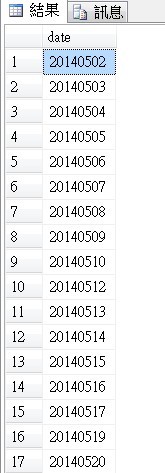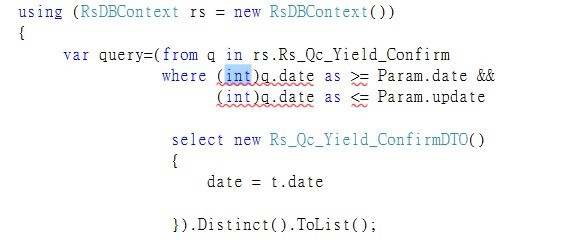linq to entities查询使用大于小于匹配数据库字符串日期方法
Posted
tags:
篇首语:本文由小常识网(cha138.com)小编为大家整理,主要介绍了linq to entities查询使用大于小于匹配数据库字符串日期方法相关的知识,希望对你有一定的参考价值。
这写日期的格式类是在数据库里是char类型,然后我想使用linq to entities查询20140503至20140510这之间的数据,由于格式问题,请教高手解答怎么去匹配条件呢?我返回的是IEnumerable

Entity Framework(LINQ to Entities)使用日期判断条件Truncate日期函数,类似Convert函数,mysql数据库可以直接使用convert(varchar(10),a.cjrq,120)
LINQ to Entities使用日期字段查询,截取日期,不包括时间,测试环境SQL Server2005/2008,Entity Framework4.0
public void TestMethod1()
using (var _context = new hotelEntities())
var rq = DateTime.Now.Date;
var query = from q in _context.UV_RZJL_RZRY_Single
where EntityFunctions.TruncateTime(q.LDRQ) >=rq
select q;
Assert.Inconclusive(query.Count().ToString());
//SqlFunctions.DateDiff的函数也可以实现
public void TestMethod1()
using (var _context = new hotelEntities())
var rq = DateTime.Now.Date;
var query = from q in _context.UV_RZJL_RZRY_Single
where SqlFunctions.DateDiff("day",rq,q.LDRQ)>0
select q;
Assert.Inconclusive(query.Count().ToString());
筛选本周数据
//获取当天的数据
DrawRecordDA _recordDA = new DrawRecordDA();
var query = _recordDA.GetQuery();
//筛选 当天
//query = query.Where(q=>SqlFunctions.DateDiff("day",q.AddTime,DateTime.Now)==0);
//筛选 当天
// query = query.Where(q=>q.AddTime.Day==DateTime.Now.Day);
//筛选 本周
query = query.Where(q => SqlFunctions.DateDiff("week", q.AddTime, DateTime.Now) == 0);
Console.WriteLine(query.Count());
var list=(from j in db.实体
where (int)j.date as >20140503&&(int)j.date<20140510).ToList();
date的长度如果大于10要强转成long追问


Convert.ToInt32(q.date)我准备用这个,执行的提示LINQ to Entities 无法辨识方法 'Int32 ToInt32(System.String)' 方法,而且这个方法无法转译成存放区运算式。


嗯,忘了跟linq数据不能C#方法处理。那就用Contains()
追问这不是模糊查询吗?
追答string不能转换成int的话就只能用匹配的方法了,linq要转换成IL的,所以不能用C#的方法处理数据库的数据。
追问也只能这样处理了,因为我数据存储的数据非常庞大,从前年就开始有数据了,所以我只能是模糊匹配大概月份,查询出List数据集了,再针对这个List去做筛选需要的!虽然的可以实现,但是也大大降低了效率!
追答这样,先用date=20140503和date=20140510的项的id,然后在用id查询这两个id之前的数据
追问最坑爹的就是,这张表没有ID!算了,朋友谢谢你了。我对这个linq查询也是刚接触,感觉用得很吃力!但是还是谢啦。
本回答被提问者采纳Linq To Entity 查询条件扩展
1 using System; 2 using System.Collections.Generic; 3 using System.Linq; 4 using System.Linq.Expressions; 5 using System.Web; 6 7 namespace Test 8 { 9 /// <summary> 10 /// 统一ParameterExpression 11 /// </summary> 12 public class ParameterReplacer : ExpressionVisitor 13 { 14 public ParameterReplacer(ParameterExpression paramExpr) 15 { 16 ParameterExpression = paramExpr; 17 } 18 19 public ParameterExpression ParameterExpression { get; private set; } 20 21 public Expression Replace(Expression expr) 22 { 23 return Visit(expr); 24 } 25 26 protected override Expression VisitParameter(ParameterExpression p) 27 { 28 return ParameterExpression; 29 } 30 } 31 /// <summary> 32 /// Predicate扩展 33 /// </summary> 34 public static class PredicateExtensionses 35 { 36 /// <summary> 37 /// 38 /// </summary> 39 /// <typeparam name="T"></typeparam> 40 /// <returns></returns> 41 public static Expression<Func<T, bool>> True<T>() { return f => true; } 42 /// <summary> 43 /// 44 /// </summary> 45 /// <typeparam name="T"></typeparam> 46 /// <returns></returns> 47 public static Expression<Func<T, bool>> False<T>() { return f => false; } 48 /// <summary> 49 /// 50 /// </summary> 51 /// <typeparam name="T"></typeparam> 52 /// <param name="expLeft"></param> 53 /// <param name="expRight"></param> 54 /// <returns></returns> 55 public static Expression<Func<T, bool>> And<T>(this Expression<Func<T, bool>> expLeft, Expression<Func<T, bool>> expRight) 56 { 57 var candidateExpr = Expression.Parameter(typeof(T), "candidate"); 58 var parameterReplacer = new ParameterReplacer(candidateExpr); 59 60 var left = parameterReplacer.Replace(expLeft.Body); 61 var right = parameterReplacer.Replace(expRight.Body); 62 var body = Expression.And(left, right); 63 64 return Expression.Lambda<Func<T, bool>>(body, candidateExpr); 65 } 66 /// <summary> 67 /// 68 /// </summary> 69 /// <typeparam name="T"></typeparam> 70 /// <param name="expLeft"></param> 71 /// <param name="expRight"></param> 72 /// <returns></returns> 73 public static Expression<Func<T, bool>> Or<T>(this Expression<Func<T, bool>> expLeft, Expression<Func<T, bool>> expRight) 74 { 75 var candidateExpr = Expression.Parameter(typeof(T), "candidate"); 76 var parameterReplacer = new ParameterReplacer(candidateExpr); 77 78 var left = parameterReplacer.Replace(expLeft.Body); 79 var right = parameterReplacer.Replace(expRight.Body); 80 var body = Expression.Or(left, right); 81 82 return Expression.Lambda<Func<T, bool>>(body, candidateExpr); 83 } 84 } 85 /// <summary> 86 /// Queryable扩展 87 /// </summary> 88 public static class QueryableExtensions 89 { 90 /// <summary> 91 /// 92 /// </summary> 93 /// <typeparam name="T"></typeparam> 94 /// <param name="queryable"></param> 95 /// <param name="propertyName"></param> 96 /// <returns></returns> 97 public static IQueryable<T> OrderBy<T>(this IQueryable<T> queryable, string propertyName) 98 { 99 return OrderBy(queryable, propertyName, false); 100 } 101 /// <summary> 102 /// OrderBy 103 /// </summary> 104 /// <typeparam name="T">实体</typeparam> 105 /// <param name="queryable">条件</param> 106 /// <param name="propertyName">属性名称</param> 107 /// <param name="desc">是否降序</param> 108 /// <returns></returns> 109 public static IQueryable<T> OrderBy<T>(this IQueryable<T> queryable, string propertyName, bool desc) 110 { 111 var param = Expression.Parameter(typeof(T)); 112 var body = Expression.Property(param, propertyName); 113 dynamic keySelector = Expression.Lambda(body, param); 114 return desc ? Queryable.OrderByDescending(queryable, keySelector) : Queryable.OrderBy(queryable, keySelector); 115 } 116 } 117 }
以上是关于linq to entities查询使用大于小于匹配数据库字符串日期方法的主要内容,如果未能解决你的问题,请参考以下文章